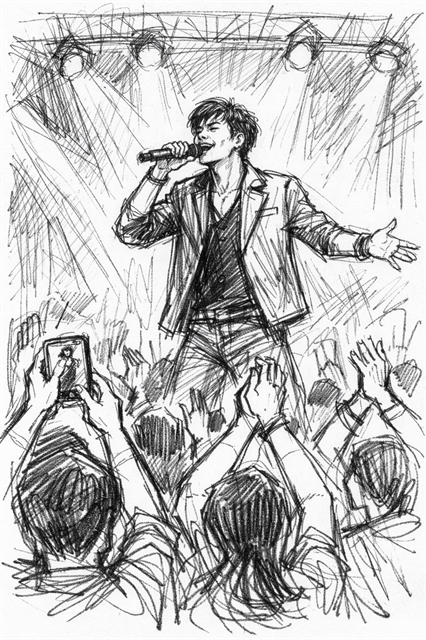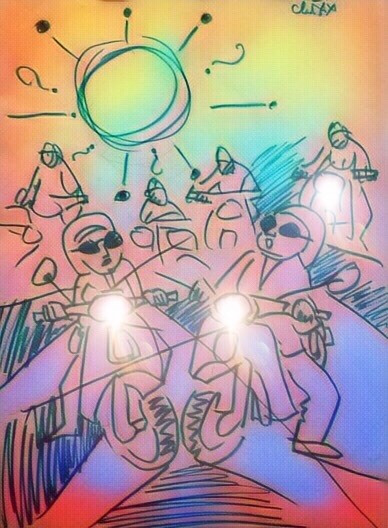 Talk Around Town
Talk Around Town


|
| Illustration by Đàm Minh Chí |
Nguyễn Hằng
A new draft law by the Ministry of Transport is aiming to shed some light on Việt Nam's traffic problem.
The draft would mean all motorbike drivers have to use their daytime running lights during the day, or if their vehicles aren't equipped with them, have the front and rear light on.
The ministry said the regulation is based on the 1968 Vienna Convention on Road Traffic, which Việt Nam joined in 2014. The ministry’s regulation aims to help road users easily identify motorbikes and thereby minimise traffic accidents – a longstanding source of tragedy in the country.
The draft has caused heated controversy, with some saying Việt Nam is too hot for such a proposal.
Phạm Thành Luân, of Hải Phòng City, said when the temperature exceeded 40 degrees Celsius in the summer, if all motorbike lights were on, it would make road users feeling hotter and uncomfortable.
Nguyễn Văn Quyền, chairman of the Việt Nam Automobile Transportation Association, said he thought the regulation was only suitable for European countries with foggy weather and that it was not necessary to turn on the light in the daytime, especially in the summer.
Turning on the light would consume a lot of electricity in the vehicle’s battery, increasing fuel consumption and causing more polluting emissions he said, adding that increased glare would also be a problem.
On the other side, many people applauded the regulation and refuted the points raised by objectors.
Doctor Ngô Chí Thanh, head of the Ophthalmology Department, Hà Nội’s Transport Hospital, said light being shone in the face would cause glare when it was dark, but not in the daytime.
Associate Professor Bành Quốc Tuấn, deputy head of Law Department, HCM City University of Technology, said motorbike drivers in developed countries, including Japan and South Korea, were required to turn on their lights at daytime a long time ago.
The same regulation had also been applied in Europe and North America for a long time, he added.
Vũ Anh Tuấn, director of Transport Research Centre under the Việt Nam – Germany University, said motorbikes were involved in 60 - 70 per cent of the total number of traffic accidents in Việt Nam. Slow recognition of the presence of motorbikes was identified as one of the major causes of many traffic accidents.
It was essential to turn on motorbike lights in the day, he said.
Tuấn said the main task of the daytime running light was not to help drivers see the road but to make it easier for other road users to identify the motorbike, meaning it wouldn't cause discomfort for other drivers.
The power for the daytime running light was taken from the motorbike’s generator, so it would not affect the motorbike’s battery, he added.
According to motorbike experts, the daytime running light is a secondary light on the vehicle, designed with low capacity, so, even if the light is turned on all the day as in the ministry’s proposal, it would not generate a large amount of heat.
Trần Hữu Minh, deputy chief of the National Committee on Traffic Safety’s Office said among ASEAN countries, only Việt Nam, Laos and Cambodia had yet to apply such a regulation.
Other countries with similar weather to Việt Nam in the bloc applied the regulation years ago, he said.
For example, Malaysia applied it in 1992, Singapore in 1995, Thailand in 2005 and Indonesia in 2009, he added.
Minh said thanks to the regulation, the number of cases of traffic accidents had reduced by 29 per cent in Malaysia, a country where motorbikes account for 50 per cent of all vehicles.
Similarly, the regulation had helped reduce traffic accidents by 20 per cent in Thailand, he said.
Minh added that many motorbike-related traffic accidents happened because other vehicles did not see the motorbike.
Additionally, all worries about glare had been solved by LED technology, Minh said.
Following an in-depth report of the Việt Nam – Germany University, the current design of the daytime running light with LED technology had been carefully calculated by motorbike manufacturers to avoid discomfort and glare for other drivers, he said.
In addition, the cost for using the light was negligible, he said.
On average, a motorbike with the light turned on for 4,000 km per year (equivalent to travelling about 10 km per day during the daytime), would only cost VNĐ15,000 (65 cents) each year more than not using it, the university estimated.
Minh also said that Việt Nam would issue an appropriate roadmap to apply the regulation.
There would be enough time for motorbike manufactures to prepare. It would also allow motorbike drivers to choose to use the daytime running light (DLR) or automatic headlamp on (AHO), he added.
Minh advised the ministry to encourage manufacturers to freely convert 40W halogen technology bulbs into 5W LED bulbs and turn-on-turn-off switch into an automatic low-beam headlight mode for old motorbikes at dealerships.
“It is just a draft law, the compilation agency welcomes constructive comments from the public so that it can carefully consider and adjust the law to be the most suitable,” he said.
Personally, I think a new regulation often causes controversy, especially, when people don't know much about it. Perhaps, agencies should disseminate so people can fully understand the new regulation before it is promulgated. A schedule to assess the regulation’s impacts on traffic accidents relating to motorbikes is also required.
If it is a good policy, the opposition will be silenced quickly. If the regulation shows effectiveness in reducing traffic accidents, people will certainly obey it like how they accepted the mandatory helmet regulation issued more than a decade ago after fierce opposition at first. — VNS




